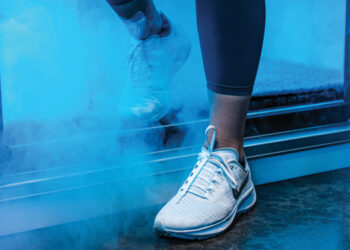It’s time we talk about one of the most overlooked pieces of any successful fitness facility — it’s sitting right on the surface. Flooring is not only one of your most significant purchases, but there are also many considerations to ensure that you have the best surfacing for your needs. Not all flooring is the same.
Location: The surfacing you choose depends on your fitness center’s location: Are you located in a multi-unit development or a stand-alone building? Where are you in the building: ground level, basement or upper floor?
No matter the developmental stage of your fitness center, pay close attention to not only its location, but also the spaces adjacent to it. Be mindful of how your center will affect neighboring businesses and residences.
For centers in multi-unit structures, locate your facility on the main floor and away from living units in order to minimize costly sound mitigation. Housing it near service entrance areas or above parking garages can also help. Whether you’re on the first or 101st floor, the material of your flooring and ceiling must suit your patrons’ needs and those of your neighbors.
Use: Your fitness center’s activities and equipment are the primary sources of noise and vibration. Consider the flooring required for each of your center’s activities, whether they are fitness machines, CrossFit classes, free weights or bouncing balls. Also, do not avoid the flooring needs of your locker rooms: Do the surfaces prevent bacterial growth and meet the needs of this high-humidity environment?
Noise and vibration: These can easily transfer to adjacent spaces in your shared building and can be a long-term nuisance. Each room of your center will have a different use and will be a source of both noise and vibration when making contact with the floor. The design of your center, as well as the flooring material, will be important factors in mitigating these potential issues.
In choosing a surfacing product, ensure that you become familiar with its acoustical testing results — any reputable manufacturer will have these on hand, if not already included within their marketing material. Perhaps the most crucial test is the Delta IIC (∆IIC), indicating the level of attenuation or sound reduction from the floor surface treatment. If they are unable to provide this number, you may want to investigate other options.
As always, consult with a professional sound and vibration expert to ensure that your flooring meets the needs of your equipment and fitness activities, and to avoid long-term problems.
These are just some of the many areas to consider when selecting your surfacing. Also keep in mind your floors’ aesthetics, warranty and maintenance plan. In doing so, you will help to keep your patrons and neighbors happy, and get a leg up on your business.
Brennan Prins is the sales manager at sofSURFACES and can be reached at 800.263.2363 x 261 or b.prins@sofsurfaces.com. For more information visit sofsurfaces.com.
Stay ahead in the fitness industry with exclusive updates!
Brennan Prins is the sales manager at sofSURFACES and can be reached at 800.263.2363 x 261 or b.prins@sofsurfaces.com. For more information visit sofsurfaces.com.










